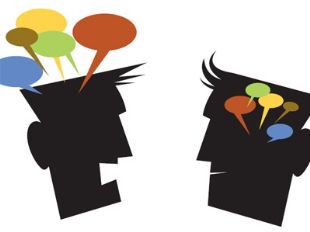It’s Just the Brain

March 23, 2017
A few weeks ago, after I settled into my Saturday-morning-TV-watching position on the couch, my mother did the unthinkable. She had me answer her cellphone. It sounds innocent enough; a call comes in and the recipient is supposed to answer. Of course, if you have crippling phone anxiety, this is more than a chore. My insides squirming and retreating deeper into me, I answered. “Hi, I’m with the Marines and was wondering what your plans are after high school,” the voice on the line said. Figuring the recruiter would soon lose interest, I answered all of his questions as politely as I could. But, when he asked whether I wanted to meet in person, I knew I was out of my depth. My mother took back her phone, ended the call, and we both chalked up my shortcomings to introversion. That is, if introversion and extroversion are synonymous with shyness and outgoingness respectively.
The most popular school of thought on the matter explains that the difference between introverts and extroverts is how a person mentally recharges. Some itch for time alone in order to tolerate groups and public activity. These introverts often struggle to handle more than one-on-one conversations. Others need extensive activity to re-energize themselves. These extroverts drum up and seek out activity. Shyness and outgoingness, then, are misnomers for these personality descriptors. Of course, extroverts are often livelier in public and introverts are often more reserved, but that is not to say that an introvert like myself is incapable of asserting himself in public or that an extrovert is incapable of being apprehensive.
Yet, introversion and extroversion may not be a matter of personality at all. Psychologist Hans Eysenck posited that the distinguishing quality between these groups is the rate of arousal in the brain. He suggested that introverts have a high rate of arousal; they need little stimulation to reach a normal level of arousal. They often need time to recharge because more activity than one-on-one conversations and predictable situations overstimulates them. Conversely, extroverts seek out stimulation because they need it to reach the level of arousal that an introvert reaches quite easily.
The difference is the pathway information takes through the brain. Extroverts process stimuli through a short pathway that runs through the amygdala, the emotion center of the brain. This route might explain their predominant personality type. Researchers have found that extroverts’ brains respond more strongly when a gamble pays off because it processes this stimulus emotionally foremost. The introverted brain processes stimulus through a complicated detour through the regions of the brain that govern memory, planning and problem-solving. This might explain why introverts are more thoughtful and less spontaneous in their decision-making. This long-held explanation of personality difference is far from psychological then. It is biology.
It is why senior Katharine Cognard-Black explains that “it is energizing to talk to people” even though she does not always feel interested in crowds, and why senior Jenny Walls struggles to sit home alone without any interaction. More to the point, her friend Julia Webster struggled to offer a response about her introversion. She asked for a weekend to think over her response, a sign that her brain processed the question in the parts of her brain dealing with logic. This stark contrast to Jennifer’s spontaneous and more emotional response reinforces the difference in their brains.
The disappointed look my mother cast on me when I struggled to take a phone call may be a matter of introversion but not shyness. It stands to reason, based on Eysenck’s theory, that my brain processed this stimulus through a longer pathway and wanted more time to prepare and reason out a response before answering. Well Mom, it’s not me; it’s just my brain.



